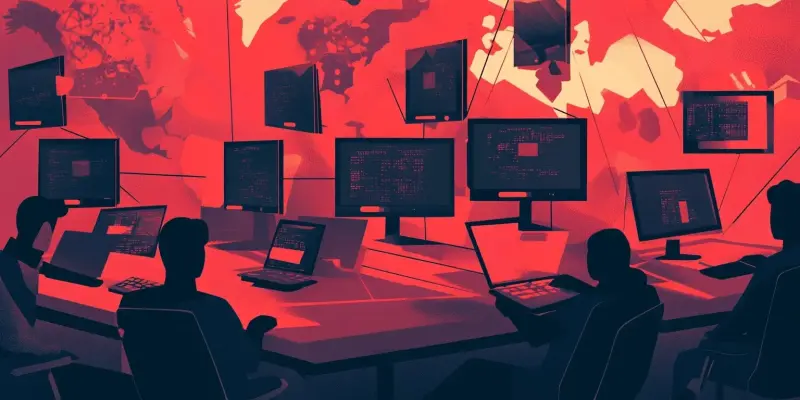In 2024, the cyber landscape demonstrated unprecedented turbulence, marked by a surge in ransomware attacks that set new records. With 5,263 attacks reported, this year saw the highest volume since 2021 according to NCC Group. These unprecedented numbers depicted a landscape heavily influenced by sophisticated nation-state espionage campaigns. LockBit emerged as the predominant threat actor, responsible for 10% of all attacks despite facing a takedown earlier in the year. However, the activities of LockBit declined compared to 2023, while another group, RansomHub, gained prominence with 501 attacks in the latter half of the year.
Regions Most Affected by Ransomware Attacks
North America’s Cybersecurity Crisis
North America bore the brunt of the ransomware rampage, experiencing a staggering 55% of the total attacks. This region, being home to some of the world’s largest corporations and critical infrastructure, became a prime target for cybercriminals seeking lucrative payouts. The financial sector, healthcare, and manufacturing industries faced relentless onslaughts, finding themselves repeatedly compromised despite robust cybersecurity measures in place. The rise of global geopolitical tensions and economic vulnerabilities exacerbated the situation, making North American entities particularly attractive targets.
The impact of these attacks has been profound, resulting in significant financial losses, data breaches, and operational disruptions. Many organizations struggled to recover, forced to reroute operations and invest heavily in security upgrades. Public services, including local government operations, were not spared, with ransomware incidents causing material downtime and affecting essential services. Despite the interventions and coordinated efforts by cybersecurity agencies, the resilience and adaptability of cyber adversaries led to continued challenges in curtailing these malicious activities.
Rising Threats in Asia, South America, and Oceania
While North America faced the majority of the attacks, Asia, South America, and Oceania also witnessed significant increases in ransomware incidents. The rapid economic growth and digital transformation underway in these regions created new vulnerabilities, making them attractive targets for cybercriminals. Asian countries, with their burgeoning technology and finance sectors, experienced persistent ransomware threats, leading to considerable disruptions in business operations and economic activities.
South America, grappling with economic challenges and political instability, saw an uptick in ransomware activities targeting its key industries. The attacks in Oceania, though smaller in number, demonstrated the global reach of these cyber threats, affecting businesses and governmental operations alike. The interconnected nature of the global economy meant that disruptions in one region had cascading effects on others, emphasizing the need for a collaborative approach to addressing these pervasive threats. The increase in ransomware incidents across these regions underscored the importance of fortified global cybersecurity strategies and proactive defense measures.
Major Sectors Targeted by Ransomware
The Industrial Sector Under Siege
The industrial sector, playing a pivotal role in the global economy, remained one of the most targeted by ransomware attackers. In 2024 alone, it accounted for 27% of all incidents, representing a 15% increase from the previous year. With 1,424 attacks, the industrial sector experienced some of the most significant disruptions, affecting critical infrastructure and services. Manufacturing plants, supply chains, and energy providers faced substantial downtime, leading to severe financial and operational consequences.
These attacks highlighted the vulnerabilities within the industrial sector, particularly concerning outdated systems and inadequate cybersecurity measures. The interconnected nature of industrial operations meant that a breach in one area could lead to widespread disruptions. The financial burden of these attacks was immense, with companies investing heavily in recovery efforts and improved security protocols. The persistent targeting of the industrial sector underscored the need for comprehensive cybersecurity strategies and the modernization of legacy systems to safeguard against future threats.
Financial and Healthcare Sectors Targeted
The financial and healthcare sectors were not spared from the wave of ransomware attacks, facing significant threats in 2024. Banks, financial institutions, and payment processors encountered numerous breaches that compromised sensitive data and disrupted operations. The sophisticated nature of these attacks often outpaced the existing security measures, pushing these sectors to reconsider their cybersecurity frameworks. The financial loss, coupled with the reputational damage, had long-term impacts on these institutions.
Healthcare providers, already under pressure from the ongoing global health challenges, faced additional burdens due to ransomware attacks. Hospitals, clinics, and research facilities found themselves in the crosshairs, with critical patient data held hostage. These incidents not only jeopardized patient care but also strained the resources of healthcare providers, forcing them to divert funds towards ransom payments and recovery efforts. The intersection of cybersecurity and public health emphasized the critical need for robust defense mechanisms to protect these vulnerable sectors.
Responses and Challenges
International Efforts and Their Shortcomings
Despite coordinated international efforts to combat cybercriminal networks, the success has been only temporary and partial. Operations such as Cronos, Magnus, Destabilise, and Serengeti saw initial success but struggled to deliver long-term protection. Organizations like LockBit exemplify the resilience of cyber adversaries, with the ability to resume operations swiftly after takedowns. The group’s warning of a strong comeback by February 2025 exemplifies the challenges faced by global cybersecurity efforts.
The capability of these criminal groups to adapt and re-emerge following disruptions indicates a pressing need for sustained and adaptive strategies. Law enforcement agencies face difficulties matching the technological prowess and financial resources of these adversaries. Furthermore, the transnational nature of ransomware attacks complicates enforcement efforts, requiring more profound international collaboration and resource sharing. This ongoing cat-and-mouse game underscores the necessity of innovative approaches and proactive measures.
New Threats and Proactive Measures
This surge in attacks underscores the evolving and increasingly complex nature of cyber threats, driven by both sophisticated nation-state actors and emerging ransomware groups. The cybersecurity community must now navigate this turbulent landscape and develop new strategies to counter these growing threats.

